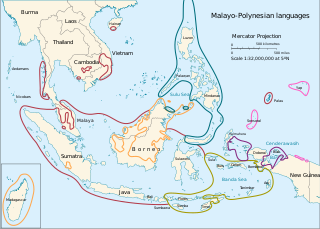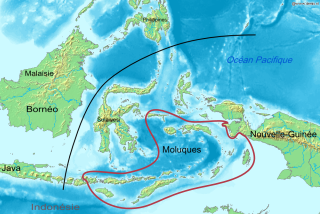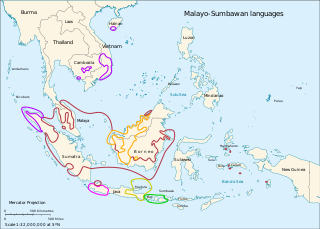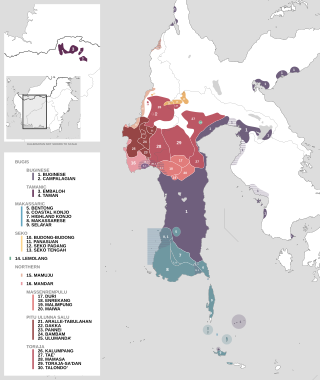
The Austronesian languages are a language family widely spoken throughout Maritime Southeast Asia,Madagascar,the islands of the Pacific Ocean and Taiwan. There are also a number of speakers in continental Asia. They are spoken by about 386 million people. This makes it the fifth-largest language family by number of speakers. Major Austronesian languages include Malay,Javanese,Sundanese,and Tagalog (Filipino). According to some estimates,the family contains 1,257 languages,which is the second most of any language family.

The Malayo-Polynesian languages are a subgroup of the Austronesian languages,with approximately 385.5 million speakers. The Malayo-Polynesian languages are spoken by the Austronesian peoples outside of Taiwan,in the island nations of Southeast Asia and the Pacific Ocean,with a smaller number in continental Asia in the areas near the Malay Peninsula. Cambodia,Vietnam and the Chinese island Hainan serve as the northwest geographic outlier. Malagasy,spoken in the island of Madagascar off the eastern coast of Africa in the Indian Ocean,is the furthest western outlier. The languages spoken south-westward from central Micronesia until Easter Island are sometimes referred to as the Polynesian languages.

The Philippine languages or Philippinic are a proposed group by R. David Paul Zorc (1986) and Robert Blust that include all the languages of the Philippines and northern Sulawesi,Indonesia—except Sama–Bajaw and a few languages of Palawan—and form a subfamily of Austronesian languages. Although the Philippines is near the center of Austronesian expansion from Formosa,there is little linguistic diversity among the approximately 150 Philippine languages,suggesting that earlier diversity has been erased by the spread of the ancestor of the modern Philippine languages.
The Central–Eastern Malayo-Polynesian (CEMP) languages form a proposed branch of the Malayo-Polynesian languages consisting of over 700 languages.

The Central Malayo-Polynesian languages (CMP) are a proposed branch in the Malayo-Polynesian subgroup of the Austronesian language family. The languages are spoken in the Lesser Sunda and Maluku Islands of the Banda Sea,in an area corresponding closely to the Indonesian provinces of East Nusa Tenggara and Maluku and the nation of East Timor,but with the Bima language extending to the eastern half of Sumbawa Island in the province of West Nusa Tenggara and the Sula languages of the Sula archipelago in the southwest corner of the province of North Maluku. The principal islands in this region are Sumbawa,Sumba,Flores,Timor,Buru,and Seram. The numerically most important languages are Bima,Manggarai of western Flores,Uab Meto of West Timor,and Tetum,the national language of East Timor.

The Batak languages are a subgroup of the Austronesian languages spoken by the Batak people in the Indonesian province of North Sumatra and surrounding areas.
Kanakanavu is a Southern Tsouic language spoken by the Kanakanavu people,an indigenous people of Taiwan. It is a Formosan language of the Austronesian family.

The Malayic languages are a branch of the Malayo-Polynesian subgroup of the Austronesian language family. The most prominent member is Malay,which is the national language of Brunei,Singapore and Malaysia;it further serves as basis for Indonesian,the national language of Indonesia. The Malayic branch also includes the local languages spoken by Indonesians and ethnic Malays,further several languages spoken by various other ethnic groups of Sumatra,Indonesia and Borneo. The most probable candidate for the urheimat of the Malayic languages is western Borneo.

Robert A. Blust was an American linguist who worked in several areas,including historical linguistics,lexicography and ethnology. He was Professor of Linguistics at the University of Hawaiʻi at Mānoa. Blust specialized in the Austronesian languages and made major contributions to the field of Austronesian linguistics.
The Sikule language is an Austronesian language spoken on Simeulue island off the western coast of Sumatra in Indonesia. It belongs to the Malayo-Polynesian branch of the Austronesian languages. Sikule is one of Northwest Sumatra–Barrier Islands languages,which are a sub-group of Western Malayo-Polynesian.
The Sangiric languages are a subgroup of the Austronesian languages spoken in North Sulawesi,Indonesia and several small islands to the north which belong to the Philippines. They are classified as a branch of the Philippine subgroup.
The Minahasan languages are a subgroup of the Austronesian languages spoken by the Minahasa people in northern Sulawesi,Indonesia. They belong to the Philippine subgroup.
The Greater North Borneo languages are a proposed subgroup of the Austronesian language family. The subgroup covers languages that are spoken throughout much of Borneo,as well as parts of Sumatra and Java,and Mainland Southeast Asia. The Greater North Borneo hypothesis was first proposed by Robert Blust (2010) and further elaborated by Alexander Smith. The evidence presented for this proposal are solely lexical.

The Malayo-Sumbawan languages are a proposed subgroup of the Austronesian languages that unites the Malayic and Chamic languages with the languages of Java and the western Lesser Sunda Islands,except for Javanese. If valid,it would be the largest demonstrated family of Malayo-Polynesian outside Oceanic. The Malayo-Sumbawan subgroup is however not universally accepted,and is rejected e.g. by Blust (2010) and Smith (2017),who supported the Greater North Borneo and Western Indonesian hypotheses. In a 2019 paper published in Oceanic Linguistics,Adelaar accepted both of these groupings,in addition to Smith's (2018) redefinition of Barito languages as forming a linkage.
The Tomini–Tolitoli languages are a disputed subgroup in the Austronesian language family spoken off the Gulf of Tomini and the district of Tolitoli in northern Central Sulawesi province,Indonesia,consisting of two branches,viz. "Tomini" and "Tolitoli". The unity of this group has not yet been demonstrated,and it may well be that the two branches actually are not closer to each other than to other languages of Sulawesi.

The South Sulawesi languages are a subgroup of the Austronesian language family. They are primarily spoken in the Indonesian provinces of South Sulawesi and West Sulawesi,with a small outlying pocket in West Kalimantan.
The Sumba–Hawu languages are a group of closely related Austronesian languages,spoken in East Nusa Tenggara,Indonesia.
Tonsawang,also known as Tombatu,is an Austronesian language of the northern tip of Sulawesi,Indonesia. It belongs to the Minahasan branch of the Philippine languages.
Southeast Babar is an Austronesian language spoken on Babar Island in South Maluku,Indonesia.
Rejang is an Austronesian language predominantly spoken by the Rejang people in southwestern parts of Sumatra (Bengkulu),Indonesia. There are five dialects,spread from mountainous region to the coastal region of Bengkulu,including the Musi (Musai) dialect,the Lebong dialect,the Kebanagung dialect,the Rawas (Awes) dialect,and the Pesisir dialect.









